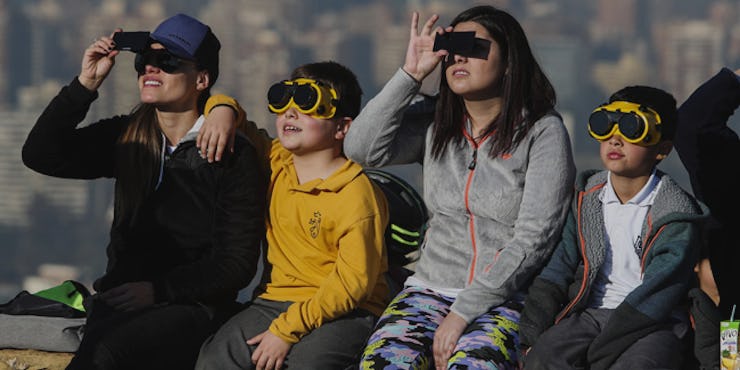Solar Eclipse South America: 6 Photos That Will Leave You Awestruck
Thousands of eclipse chasers flocked to Chile to see a once-in-a-lifetime celestial event

The total solar eclipse that gently breezed over South America Tuesday afternoon was watched by millions around the world, not only in Chile and Argentina, where the best view was to be had, but also online in real time as the cosmic ballet unfolded.
According to The Times of Chile, celebrity eclipse aficionados making the pilgrimage included lead guitarist Brian May from the band Queen (who also happens to be an astrophysicist) Microsoft founder Bill Gates, former US president Bill Clinton, and Virgin Galactic founder Richard Branson. Although none of these have been officially confirmed. (On closer inspection however, it looked like Brian May was actually tweeting from rehearsals in California.)
The view of the eclipse from La Higuera, Chile. CREDIT: Esteban Felix/AP/Shutterstock
The ghostly wisps of the solar corona from behind the moon CREDIT: Phil Plait/exploratorium.edu
“Astronomy and the beauty of the pristine Chilean skies will be showcased to the entire world, as the rarity of the total eclipse will attract thousands of people, from both Chile and further afield, to the north of the country,” Claudio Melo, European Southern Observatory (ESO) spokesperson in Chile said in a statement.
Thousands of tourists and locals gathered to watch at La Higuera, Chile. CREDIT: Esteban Felix/AP/Shutterstock
How a Total Solar Eclipse Occurs
A total solar eclipse occurs when the moon covers the face of the Sun as seen from Earth. By a staggering, mind-boggling coincidence, the moon (2,158 miles in diameter) — as seen from Earth (a distance of 238,900 miles) appears exactly the same size as the sun (864,340 miles in diameter) as seen from Earth (a distance of 93 million miles).
The Sun’s corona – the extended atmosphere, shaped by the magnetic field – seen in this image composition CREDIT: ESA
The view from orbit was just as amazing, but for slightly different reasons. A major hurricane was percolating above the Pacific ocean north of the equator and just west of Mexico.
Hurricane Barbara was officially declared a Category 4 storm on Tuesday and was visible from space at the same time as the eclipse.
The shadow of the total solar eclipse passing south of Hurricane Barbara CREDIT: NOAA/College of DuPage/Dakota Smith
Both phenomena were captured by cameras on satellites in geostationary satellites hovering roughly 22,300 miles from Earth’s surface. The College of DuPage’s NEXLAB satellite captured it all in glorious color and it was processed into a stunning timelapse by meteorologist Dakota Smith.
The view from the La Silla observatory in Chile and the stars that were also visible. CREDIT: ESO
Although solar eclipses happen a few times a year, total solar eclipses don’t occur that often. The next one is due to take place in December 2020, with the path of totality once again cutting across Chile and Argentina.
You can check out NASA’s eclipse website for a timetable of future eclipses.